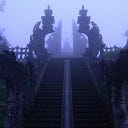The Dewata Nawa Sanga (“Surya Majapahit”)
Originally posted on Indosphere.co
The Surya Majapahit is perhaps the most recognizable of all Indonesian symbols. It is a cosmological diagram which forms an octagonal mandala, holding the Eight Guardians of the Directions placed at the eight cardinal points.
Together, the Eight Guardians with Shiva in the center are known as the Nava-Dikpāla (‘Guardians of the Nine Directions’), or Dewata Nawa Sanga.
It is a holy symbol that functions as a powerful protection and prosperity talisman. It is related to the Star of Lakshmi, source of the Ashṭalakshmi (‘Eight Forms of Wealth’).
There are also eight minor deities, or Lokapāla (‘Guardians of the Worlds’) located at the outer rim of the Sun diagram:
In Indonesian Hindu Dharma, the highest principle is Parama Shiva (God, the Supreme Creator). The Dewata Nawa Sanga are the manifestations (tattvas) of this highest power in Space and Time.
Each direction of Space is therefore occupied by certain gods along with their colors, weapons, scriptures holy syllable and spiritual functions.
In the center of all of these, Shiva is the highest principle, permeating, preserving and neutralizing the Universe with all its contents. He is transcendental and immanent. He is both Nirguna and Saguna Brahman.
The Dewata Nawa Sanga are the Nine deities which occupy the Eight wind directions plus one in the middle. They become eleven when integrated with the layers of Space towards the vertical bottom and vertical top. They are one as the power of God in keeping the balance of the Universe.
Because of the popularity of this Sun symbol during the Majapahit period, it is nowadays called “Surya Majapahit”, although its origins trace back to the origins of the Sanatana Dharma, several thousands of years ago.
The Dewata Nawa Sanga is one of the mysterious connections between Indonesian and Central American cultures
The Dewata Nawa Sanga carving is often found on the ceiling of the Garbhagriha of temples. We can see it in the Bangkal, Sawentar and Jawi temples. It is sometimes engraved as just a simple eight-pointed sun ray such as the one set into the ceiling of Candi Penataran.
Image source — Didi Trowulanesia
The carving of Dewata Nawa Sanga is also commonly found on gravestones of the Majapahit era, such as in the Troloyo cemetery in Trowulan.
Its principles are used for the construction of houses and temples, according to the principles of Vaastu Shastra (sacred architecture) in Java and Bali. It is sometimes congruous with the Wheel of Dharma in temple iconography:
The Dharmacakra (‘Wheel of Dharma’) merged with the shape of the Dewata Nawa Sanga
The Star of Lakshmi was later adapted by the Moslems under the name of “Rub El Hizb”, which is why it is nowadays found on mosques in a much simplified form.
In Java, the Moslems also created the concept of the “Wali Songo” (a semi-mythical gathering of ‘nine Moslem saints’) in order to replace the worship of the Dewata Nawa Sanga among the Javanese.
https://www.youtube.com/watch?v=95KgYG3yrMk
Mudras of the Dewata Nawa Sanga
